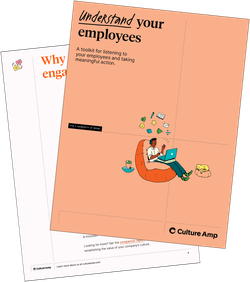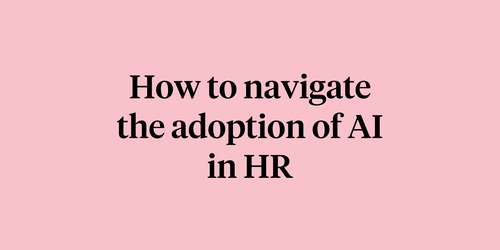
When you ask employees to share their feelings and experiences about work and then nothing seems to happen as a result, employees quickly disconnect from the feedback process.
When it comes to employee engagement, it’s not enough to survey employees. After all, conducting a survey is just the first step. Nor is it enough for leaders simply share results – through communicating survey results is undoubtedly important. But, the most effective way to show employees they’re being listened to is to take action. Specifically, you want to prioritize and implement targeted employee engagement ideas and initiatives that respond directly to your employees' feedback.
Deciding which actions to take can be challenging, so we’ll share a range of employee engagement ideas to consider in this blog. We know they work because either our customers have used them or we’ve used them and experienced success.
Specifically, we'll be looking at engagement initiatives that align with the four key factors that drive employee engagement:
- Leadership
- Enablement
- Alignment
- Development
Leadership-focused employee engagement ideas
Employees want to have confidence in their leaders and be inspired and engaged by them. They also want their leaders to recognize the importance of their employees.
Here are two ways organizations can act to improve leadership:
1. Hold synthesis sessions
In monthly "synthesis sessions," a leader in each department discusses current challenges and successes and changes in market position(s). The first 15 minutes of the session should be led by the leader, who shares current opportunities and discusses future possibilities.
The remaining time is devoted to open discussion on any questions employees have about the organization and concerns that individuals may have about blockers to their ability to help the organization achieve its goals.
2. Bring company values to life
A national casual dining organization created a "Book of Signs" to bring their values to life while onboarding new employees. It’s a simple thing – a small paper booklet with the name and description of a single value on each page and two or three lines for employee signatures under each value.
To "earn" an employee’s signature on a value, the new hire has to ask what that value means to that employee. Then, the newcomer paraphrases the response to ensure they understand its meaning and relevance. If they do, the incumbent signs it off.
A "Book of Signs" is a win-win-win for bringing your company values to life and expanding the newcomer’s internal network.
Enablement-focused employee engagement ideas
Enabled employees feel they have the right resources and tools to do the job. After all, employees want to feel confident that their time and resources are being directed to the right places. At a higher level, employees want to see innovation happening and that the company maintains a strong position in the market.
Here are two initiatives that target enablement:
3. Create a transparency report
Consider drafting a resource transparency report, including ROI, where possible. A transparency report helps guide constructive discussions about whether the resources allocated to each initiative are appropriate. Employees are often surprised by how much money is spent on salaries and employee benefits.
4. Host a customer panel
There’s nothing like bringing in the voice of the customer to help employees connect to the bigger picture. Make this voice a regular presence by inviting a panel of customers to participate in your all-hands meetings.
Each customer explains how using your product or service has positively impacted their business and shares what they wish the product or service could do (or ways the product or service failed them). A similar approach can be used with internal customers.
Alignment-focused employee engagement ideas
Employees want to feel like their job is worthwhile, connected to their team, and appropriately involved in the organization’s operations. They also want to feel that their abilities are well-matched to their role, so setting realistic expectations about the role (e.g., when recruiting) is essential. When the day-to-day experience within a role doesn’t stack up against expectations, it significantly impacts engagement.
Here are three initiatives that help build alignment:
5. Ask employees to write their role description
Ensuring alignment in job expectations starts from the first day of employment. At one company, employees write down their understanding of their job's expectations on the first day at work. This is put aside to be reviewed about a month later when employees are again asked to write what they think their job description is. In this second instance, the question posed to them is, "If we were to hire someone like you in this role in the future, how would you describe the activities?"
The original job description and the more recently written job description are reviewed by and with the manager. If there is a misalignment, the manager and employee are encouraged to discuss any adjustments that can be made. The manager is also encouraged to share learnings with HR to make any needed adjustments in the hiring process or job descriptions.
6. Create an online communication channel for leaders
One organization helps build employees’ involvement with leaders via a channel in their internal communication software where leaders are present and available to answer questions. They also encourage leaders to post questions and updates in the channel to keep employees engaged with the discussion. For example, Culture Amp has a Slack channel dedicated exclusively to CEO communications (#ceo).
7. Recognize employee behavior
It’s easy to get caught up in the day-to-day, but the best leaders recognize good work and behaviors – big and small.
Here are three ways our clients recognize their people:
- Thank you cards. One organization provides thank-you cards for people to complete and hand-deliver. The HR team creates templates that link to the company values and current organizational objectives. This is a great way to reinforce your vision and values while acknowledging exemplary behaviors.
- Events. A schedule of events where employees are recognized for their work ensures intentionality and follow-through. One organization has monthly recognition events. They recognize good work and highlight what people are working on and how it's helping the organization deliver on its mission and work toward its vision.
- The Wow! Wall. One company we work with has a "Wow! Wall" where people can post stories of when their co-workers have gone above and beyond. The wall is in a high-traffic area, so everyone can casually pass by and read about the great work of their colleagues.
Development-focused employee engagement ideas
Employee development comes up repeatedly across all the industries we work with as a critical driver of employee engagement. As a matter of fact, we know that development is the top reason an employee chooses to leave their company. If you want to improve engagement, you must ensure employees have access to formal and informal development opportunities. You also want to make it clear that leaders and managers are invested in employees' professional development.
Here are three development initiatives to drive employee engagement:
8. Offer personal coaching
Culture Amp provides personal coaching for every employee. The employee selects their coach for either personal or professional development. The company sets an allocated budget and a set number of sessions, but the coaching content is decided by the employee. Moreover, anything covered in the sessions remains between the coach and the employee.
9. Hold stay interviews
One company uses "stay interviews" as a way to re-engage with employees that are at risk of leaving. Employees are encouraged to discuss their career development needs and any blockers to their long-term success at the organization.
In departments with higher turnover rates, it can be helpful to have a skip-level meeting with someone more senior in the organization, rather than a direct manager, intermittently throughout the employee lifecycle.
At the team level, managers might wish to schedule stay interviews with employees when they hit their one-year mark, so they know what is essential to people and most likely to influence their decision to stay.
Good questions to ask include:
- What do you want to be doing that you aren't currently doing?
- What are the three most important things you want to accomplish now?
- What do you need that's preventing you from reaching those goals?
- How can I best support you in achieving those goals?
10. Create a system for employee-led teaching programs
Encourage employees to learn from each other. One organization's learning and development programs are taught by employees. These employees teach classes and workshops ranging from extracurricular skills to those essential to their roles. The community aspect fosters collaboration and team support.
These employee engagement initiatives are the ultimate in active listening. By taking intentional action that responds to employee feedback, your organization can show they have both (figurative) ears open. This is the key to creating a great place to work.
Choose the engagement initiative that’s right for your company
Whether you try out one of the employee engagement initiatives above or create your own, it’s important to understand how to improve employee engagement overall. This process starts with crafting your survey and asking the right employee engagement questions to understand what’s driving engagement. Once you know what's driving engagement at your company, you can take targeted action for change.

Understand your employees
Build a more productive and resilient workplace.


